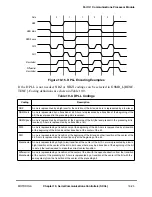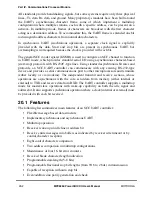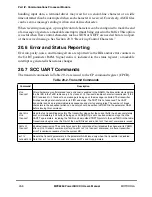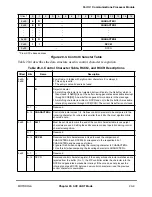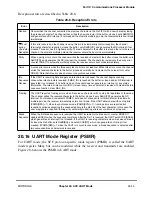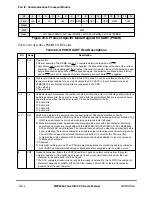
MOTOROLA
Chapter 20. SCC UART Mode
20-7
Part IV. Communications Processor Module
Receive commands are described in Table 20-3.
20.8 Multidrop Systems and Address Recognition
In multidrop systems, more than two stations can be on a network, each with a speciÞc
address. Figure 20-2 shows two examples of this conÞguration. Frames made up of many
characters can be broadcast as long as the Þrst character is the destination address. The
UART frame is extended by one bit to distinguish an address character from standard data
characters. Programmed in PSMR[UM], the controller supports the following two
multidrop modes:
¥
Automatic multidrop mode
Ñ
The controller checks the incoming address character
and accepts subsequent data only if the address matches one of two user-deÞned
values. The two 16-bit address registers, UADDR1 and UADDR2, support address
recognition. Only the lower 8 bits are used so the upper 8 bits should be cleared; for
addresses less than 8 bits, unused high-order bits should also be cleared. The
incoming address is checked against UADDR1 and UADDR2. When a match
occurs, RxBD[AM] indicates whether UADDR1 or UADDR2 matched.
¥
Manual multidrop mode
Ñ
The controller receives all characters. An address
character is always written to a new buffer and can be followed by data characters.
User software performs the address comparison.
Table 20-3. Receive Commands
Command
Description
ENTER
HUNT
MODE
Forces the receiver to close the RxBD in use and enter hunt mode. After a hardware or software reset,
once an SCC is enabled in the GSMR, the receiver is automatically enabled and uses the Þrst BD in the
RxBD table. If a message is in progress, the receiver continues receiving in the next BD. In multidrop
hunt mode, the receiver continually scans the input data stream for the address character. When it is not
in multidrop mode, it waits for the idle sequence (one character of idle). Data present in the Rx FIFO is
not lost when this command is executed.
CLOSE
RXBD
Forces the SCC to close the RxBD in use and use the next BD for subsequent received data. If the SCC
is not in the process of receiving data, no action is taken.
Note that in an SCC UART controller,
CLOSE
RXBD
functions like
ENTER
HUNT
MODE
but does not need to
receive an idle character to continue receiving.
INIT
RX
PARAMETERS
Resets the receive parameters in the parameter RAM. Should be issued when the receiver is disabled.
Note that
INIT
TX
AND
RX
PARAMETERS
resets both Tx and Rx parameters.
Summary of Contents for MPC8260 PowerQUICC II
Page 1: ...MPC8260UM D 4 1999 Rev 0 MPC8260 PowerQUICC II UserÕs Manual ª ª ...
Page 66: ...lxvi MPC8260 PowerQUICC II UserÕs Manual MOTOROLA ...
Page 88: ...1 18 MPC8260 PowerQUICC II UserÕs Manual MOTOROLA Part I Overview ...
Page 120: ...2 32 MPC8260 PowerQUICC II UserÕs Manual MOTOROLA Part I Overview ...
Page 138: ...Part II iv MPC8260 PowerQUICC II UserÕs Manual MOTOROLA Part II Configuration and Reset ...
Page 184: ...4 46 MPC8260 PowerQUICC II UserÕs Manual MOTOROLA Part II ConÞguration and Reset ...
Page 202: ...Part III vi MPC8260 PowerQUICC II UserÕs Manual MOTOROLA Part III The Hardware Interface ...
Page 266: ...8 34 MPC8260 PowerQUICC II UserÕs Manual MOTOROLA Part III The Hardware Interface ...
Page 382: ...10 106 MPC8260 PowerQUICC II UserÕs Manual MOTOROLA Part III The Hardware Interface ...
Page 392: ...11 10 MPC8260 PowerQUICC II UserÕs Manual MOTOROLA Part III The Hardware Interface ...
Page 430: ...Part IV viii MOTOROLA Part IV Communications Processor Module ...
Page 490: ...14 36 MPC8260 PowerQUICC II UserÕs Manual MOTOROLA Part IV Communications Processor Module ...
Page 524: ...17 10 MPC8260 PowerQUICC II UserÕs Manual MOTOROLA Part IV Communications Processor Module ...
Page 556: ...18 32 MPC8260 PowerQUICC II UserÕs Manual MOTOROLA Part IV Communications Processor Module ...
Page 584: ...19 28 MPC8260 PowerQUICC II UserÕs Manual MOTOROLA Part IV Communications Processor Module ...
Page 632: ...21 24 MPC8260 PowerQUICC II UserÕs Manual MOTOROLA Part IV Communications Processor Module ...
Page 652: ...22 20 MPC8260 PowerQUICC II UserÕs Manual MOTOROLA Part IV Communications Processor Module ...
Page 668: ...23 16 MPC8260 PowerQUICC II UserÕs Manual MOTOROLA Part IV Communications Processor Module ...
Page 758: ...27 28 MPC8260 PowerQUICC II UserÕs Manual MOTOROLA Part IV Communications Processor Module ...
Page 780: ...28 22 MPC8260 PowerQUICC II UserÕs Manual MOTOROLA Part IV Communications Processor Module ...
Page 874: ...29 94 MPC8260 PowerQUICC II UserÕs Manual MOTOROLA Part IV Communications Processor Module ...
Page 920: ...31 18 MPC8260 PowerQUICC II UserÕs Manual MOTOROLA Part IV Communications Processor Module ...
Page 980: ...A 4 MPC8260 PowerQUICC II UserÕs Manual MOTOROLA Appendixes ...
Page 1002: ...Index 22 MPC8260 PowerQUICC II UserÕs Manual MOTOROLA INDEX ...
Page 1006: ......





